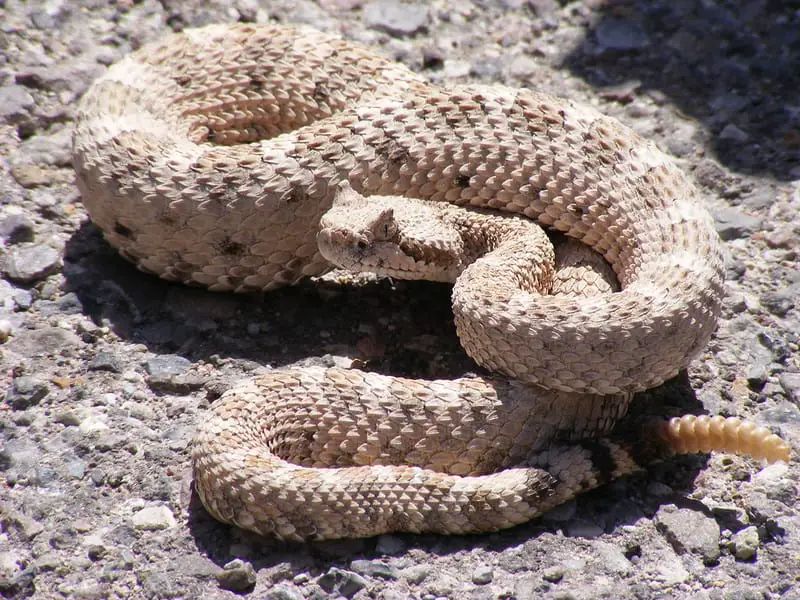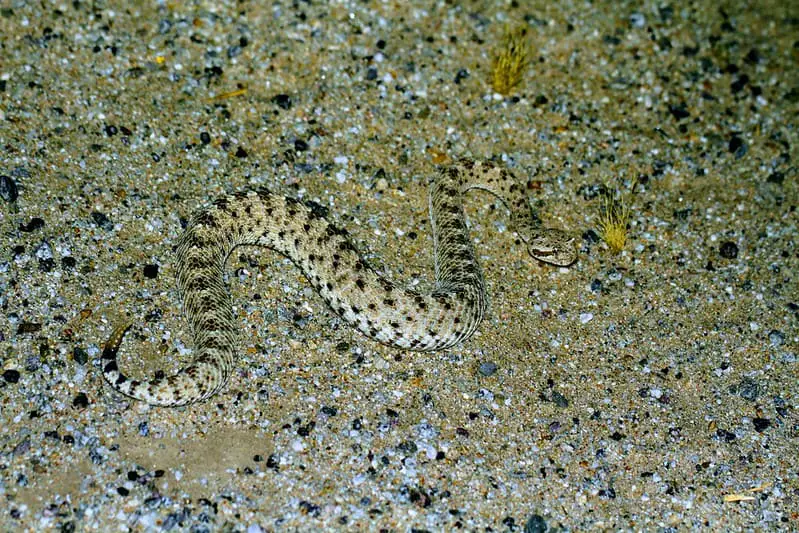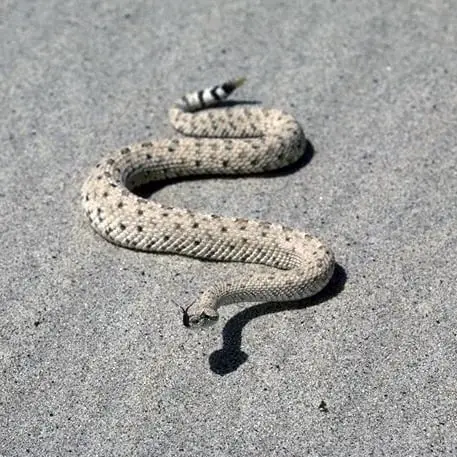Crotalus cerastes, commonly called the sidewinder rattlesnake or the horned rattlesnake is a small venomous pit viper snake. It can be found in the sandy desert areas of the Southwestern United States and Northwestern Mexico. Thanks to its sidewinding movements, it is the fastest-moving snake species on sand.
Description
The sidewinder, or horned, rattlesnake is a pit viper species perfectly adapted to life in the desert. Its body is colored to provide the perfect camouflage in the desert sand. It is usually cream-colored with several small darker blotches along its body. The following video gives a great overview of the physical appearance of the snake. It also explains how the sidewinding movements of the snake works. With speeds up to 18 mph (29 km/h), the sidewinder snake is the fastest snake on sand.
Next to its lighter color and smaller size than most other rattlesnake species, the upward-facing scales over its eyes are the most characteristic features of the sidewinder rattlesnake. These “horns” have also earned it the name horned rattlesnake. The horns are believed to serve as protection from the strong desert sun as well as to prevent sand from entering the eyes.

Size
The sidewinder snake is one of the smallest species of Crotalus rattlesnakes. Most adults reach a maximum size of 20-32 inches (50-80 cm). In contrast to most other rattlesnakes, female sidewinder rattlesnakes are larger than the male.
Bite and Venom
The venom of the sidewinder rattlesnake iss less potent than that of most other rattlesnakes. Also, due to its smaller size, it can only administer a smaller amount of venom with a single bite. These two facts make the sidewinder rattlesnake less dangerous than its larger relatives. However, keep in mind that this is still a dangerous and potentially deadly snake. If you encounter a sidewinder rattler, do not approach the snake and slowly move away from it.
If you are bitten by a sidewinder, you need to get medical attention immediately. Try to remain calm. Do not tie off the affected area and do not stop the bleeding if you are bleeding. Try to keep your heart rate as low as possible and get medical attention as soon as possible. The person who got bitten should move as little as possible. Either take a car to the nearest hospital, or if you are on foot, call an ambulance.
Diet an Habitat
The sidewinder rattlesnake is perfectly adapted to a life in the sandy deserts. With its camouflage, it can hide in the sand and wait for a suitable prey animal to pass close enough. Thanks to the incedible speed at which it can move over sand, it can also hunt prey animals. The preferred prey of adults are desert rodents and reptiles. Juvenile snakes use their rattler as a lure to attract small reptiles like lizards. They bury their body in sand or under a rock and mimic the movements of caterpillars. As soon as the unsuspecting lizard wants to take a bite at the seemingly juicy caterpillar, the snake will deal a deadly bite to the attacker.

Sidewinder rattlesnake range in the USA
In the United States, the sidewinder rattlesnake can be found in the desert areas of Southeastern California, southern Nevada, the southeastern part of Utah, and Eastern Arizona.
Scientific classification of Crotalus cerastes
- Kingdom: Animalia
- Phylum: Chordata
- Class: Reptilia
- Order: Squamata
- Suborder: Serpentes
- Family: Viperidae
- Subfamily: Crotalinae
- Genus: Crotalus
- Species: Crotalus cerastes
Subspecies of the Sidewinder or Horned Rattlesnake
Currently, three subspecies of the sidewinder rattlesnake are known:
- Crotalus cerastes cerastes, Mojave Desert sidewinder – from northeast of Los Angeles in California to Nevada, Utah and western Arizona.
- Crotalus cerastes cercobombus, Sonoran Desert sidewinder – Found in the Sonoran Desert. In the United States in Arizona – Yuma, Maricopa, Pima and Pinal Counties
- Crotalus cerastes laterorepens, Colorado Desert sidewinder – Desert areas from Riverside County, CA, to Pinal County, AZ.
